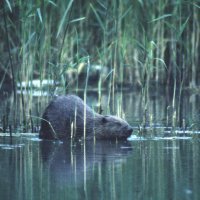 Bildrechte: B. Königstedt
Bildrechte: B. Königstedt
The Elbe and its Tributaries
With a length of 1,094 km from its source in the Giant Mountains in the Czech Republic to the point where it enters the North Sea near Cuxhaven, the Elbe is Europe’s fourth longest river. It has a catchment area of 148,268 km².
Throughout its course from the mountains to the sea, the Elbe makes a major impact on the structure and the hydrological situation of the surrounding countryside. Both the river’s course as well as the riverine habitat types remain to a large extent in a near-natural condition.
In the part of its course known as the Lower Middle Elbe, the gradient is low, averaging 13 cm per km with a mean velocity of 3 km per hour. This means that a great deal of sand carried down from upstream areas is deposited here. As recently as during the nineteenth century, this resulted in shifting sandbanks and the formation of river islands. Today, the course of the river has been fixed through the construction of groynes.
Whenever there is heavy and persistent rainfall in the upper catchment area, and when the snow on the mountains melts, the Elbe carries so much water that floods are likely to occur. The pressure of the floodwater from the Elbe may be so great that its tributaries back up and these rivers escape from the confines of their banks.
In the Lower Saxonian part of the biosphere reserve, the tributaries Aland, Seege and Jeetzel enter the Elbe on its left bank and the Löcknitz and the Sude enter on the right bank. Also, the rivers Krainke and Rögnitz flow at a leisurely pace through the Elbe lowlands before joining the Sude shortly before the Sude enters the Elbe. These days, very large scale flooding of the lowlands is prevented by dykes and weirs.
Until the beginning of the 20th century the fish stocks in the Elbe were extremely plentiful. Salmon (Salmo salar), lamprey (Lampetra fluviatilis), burbot (Lota lota) and zander (Stizostedion lucioperca) were important sources of food for the local inhabitants. Construction works and chemical pollution from the upstream regions then caused a rapid and dramatic fall in the fish stocks, which are now responding positively to subsequent improvements in the quality of the water. Current surveys have established that 52 species are now present in the Middle Elbe. One of the indicator species for the Elbe is the asp (Aspius aspius).
Bird populations use the Elbe and its lowlands as a staging post and for orientation during migration, and some of them also use them as their winter quarters. In winter, the calm areas of water between the groynes in the rivers as well as neighbouring bodies of water are transformed into huge dormitories for thousands and thousands of resting birds. It is a very remarkable sight when swarms of white fronted geese (Anser albifrons), bean geese (Anser fabalis), whooper swans (Cygnus cygnus) and Bewick’s swans (Cygnus columbianus) arrive in search of resting places, their myriad voices combining to create an impressive cacophony.
During the nineteen-nineties, the beaver (Castor fiber) returned to the Lower Saxonian Elbe Lowlands, where it had been extinct since 1819. Now beaver populations are spreading along the Elbe and its tributaries, and the total population has risen to 500. Similarly, the European otter (Lutra lutra) is making a comeback, using the Elbe as one of its principal corridors within Lower Saxony.
 Bildrechte: B. Königstedt
Bildrechte: B. Königstedt
The beaver (Castor fiber) returned to the Lower Saxonian Elbe Lowlands, where it had been extinct since 1819.



 deutsch
deutsch english
english